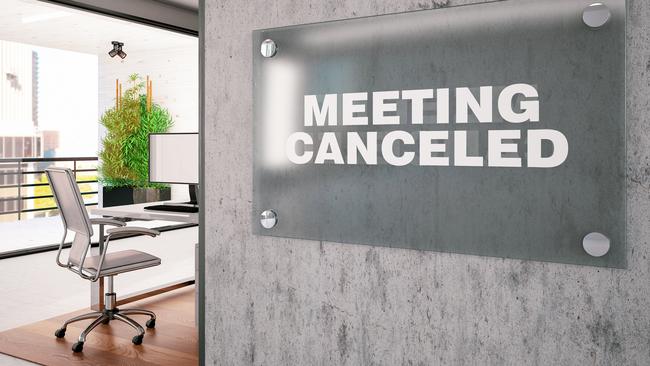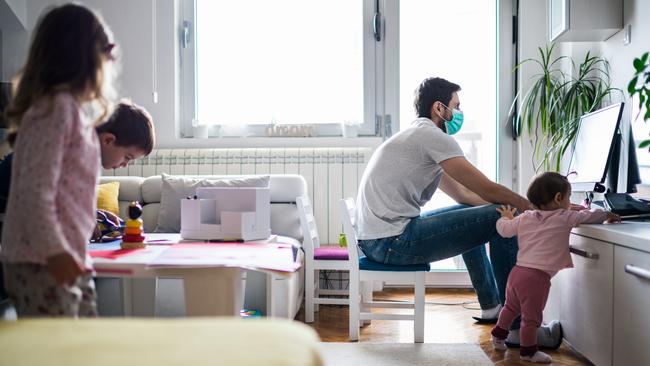Coronavirus Australia: Will the office still be there when it’s time to go back?
As companies prepare for employees to return, they are asking whether a traditional headquarters is still necessary.

Someday the coronavirus pandemic will release its grip on our lives and we will return to the workplace. The question is: Will there be an office to go back to when this is all over?
The changes the business world is considering offer a radical rethinking of a place that is central to corporate life. There are likely to be fewer offices in the centre of big cities, more hybrid schedules that allow workers to stay home part of the week and more elbow room as companies free up space for social distancing. Smaller satellite offices could also pop up in less-expensive locations as the workforce becomes less centralised.
In San Francisco, Twitter notified employees this week that most of them could continue to work from home indefinitely. Canadian information-technology provider OpenText Corp. expects to eliminate more than half of its 120 offices globally. And Skift, a New York media company, is giving up its Manhattan headquarters when its lease expires in July.
The modifications could have a profound impact on millions of workers who defined their work lives around a daily trip into “the office”, with consequences that aren’t yet known. Some employees in coastal cities might be able to take their existing salaries to places with a lower cost of living. But that may also mean those workers can be easily replaced by someone offshore, where costs are even lower. Employees would gain flexibility, but they might miss the temporary respite from domestic responsibilities and exchanging ideas in more impromptu ways. Big companies would save on real estate costs, but they might struggle to outbid smaller companies for the best talent if traditional office perks like free food and bike storage are no longer as essential as they once were.
The zeal for a new definition of the traditional office is driven in part by the shrinking economy, as companies look for new ways to cut costs during a downturn that is expected to be the worst since the Great Depression. Many executives also point to the success of an unprecedented work-from-home experiment, and how little productivity appears to have been impacted after millions of employees in technology, media, finance and other industries have been forced to work remotely for months.
“I mean, if you’d said three months ago that 90 per cent of our employees will be working from home and the firm would be functioning fine, I’d say that is a test I’m not prepared to take because the downside of being wrong on that is massive,” said Morgan Stanley Chief Executive James Gorman in mid-April on the bank’s earnings call.
The biggest loser in the rise of a reimagined office could be the commercial real-estate market and the big institutional investors that have invested heavily in it. Pension funds, insurance companies and other institutions have spent billions of dollars to buy big city office towers in cities. They are depending on continued tenant demand that now looks poised to slow.

Company culture
This doesn’t mean urban offices are disappearing anytime soon. Leases are hard to tear up, and few companies want to ditch the office altogether. There were also other periods where the end of the centre-city office building was wrongly predicted, beginning in the latter half of the 20th century as some companies decamped to suburban office parks and following the shock of 9/11. Each time the centralised office building proved to be surprisingly resilient.
Many who are attached to the real-estate industry still say there is no substitute to having all employees under one roof.
Will Silverman, a managing director at real-estate investment banking firm Eastdil Secured LLC, describes “a firm-wide culture” as a key development in business over the past couple of decades — “the idea that having the right firmwide culture can make your company successful”.
“I just don’t know how you establish a culture among people who are only together a few days a week,” he says
Some companies, however, are already planning their retreat from traditional offices while a deadly virus spreads across the globe. OpenText’s elimination of more than half its offices will result in 2000 of the company’s 15,000-person workforce working from home permanently across back-office roles, client relations and technology support, according to Chief Executive Mark Barrenechea. The company makes information-management software. “At this scale this is certainly being driven by the pandemic,” he says.
To keep the company’s culture intact while its people are physically apart, OpenText is conducting online happy hours, virtual chess tournaments and game nights while encouraging employees to use videoconferencing backgrounds that showcase their personalities.
“I stepped back and said, ‘OK, it’s working for us,’” Barrenechea says.

The enterprise information-management software company is in the process of determining which office leases to let expire and which to renegotiate with landlords, he adds.
In Silicon Valley, where company culture was always a cornerstone of startup life, some of the biggest companies were the first to embrace the concept of working remotely through the pandemic. Now they are also re-imagining how workers will congregate in the future.
Twitter Chief Executive Jack Dorsey notified employees last Tuesday that they would be able to work from home even after the pandemic is over, with exceptions for some jobs that can’t be done remotely. Twitter doesn’t plan to close or shrink any of its offices.
Since the pandemic started, the social media company has been hosting virtual events to foster interaction between employees. Twitter’s chief human resources officer, Jennifer Christie, says more people engage in the meetings now that they are virtual. They also create a level playing field. “Everyone has the same experience,” Christie says.
In the past decade, corporations have tried to reduce their office space by squeezing in as many employees as possible on their floors, but social-distancing rules make that increasingly difficult. Now, many companies say they will allow more people to work from home and restructure office floors to allow for greater spacing. Companies typically spend 2 per cent to 3 per cent of their revenues on office space, according to real-estate analyst Green Street Advisers.
Belden, a St Louis-based manufacturing company, currently has an office layout where executives have closed-door offices and other employees have cubicles and desks.
“I reflect on that and I’m like ‘it’s a complete waste of space’,” says chief executive John Stroup.
Belden would be better served having conference rooms for people to meet in and office sites with open desks where employees can bring their own laptops on the days they work from the office, he says. Belden employs 10,000 and makes fibre optic and industrial cables for telecommunications, healthcare and other industries.
The CEO says he is noticing improvements in how employees interact virtually. In March multiple people would speak awkwardly at the same time on videoconference calls; last week he noticed more similarities to how people might interact in person, with “more joking around and more perception of body language”.
The company is re-evaluating its real-estate footprint and office layout to accommodate a schedule where employees could work from home some days each week, Stroup says. Maintaining the company’s culture while doing so “is something we’ll have to figure out and in my view not something that’s insurmountable.”
Hybrid offices
Some executives say offering the option to work from home keeps employees happy and helps attract better job candidates. Discovery, the parent company of TV channels TLC and Food Network, says a survey showed that employees would prefer to work from home two days a week even when things return to “normal,” said Adria Alpert Romm, the company’s chief people and culture officer.
“It’s worked better than we ever would have imagined,” she says. “We will most definitely provide the opportunity to have this hybrid schedule because it’s working.”
Some companies are ditching the office altogether. Skift, a roughly 60-person business media company that covers the travel industry, is giving up its office in Midtown Manhattan when the company’s lease expires in late July. It also won’t renew a deal for a co-working space for London-based employees. The moves will save the company close to $US600,000 ($935,000) annually, including expenses for utilities, office snacks and commuter benefits for employees, says Rafat Ali, Skift’s chief executive.
The company may rent a flexible working space for perhaps one or two days a week in the future so employees can physically come together.
“It comes down to, one, saving money at this point,” Ali says. “We’ve learned the taste of what it is to not be in an office, and I think this is the perfect time.”
Finding a middle ground
There are multiple reasons why some companies might resist an outright retreat from the office. While many jobs can be done remotely, creative types often benefit from being around others and having all employees in one place makes collaboration easier.
Some companies see big offices as a way to safeguard sensitive information and keep an eye on their employees.
Certain employees are also more dependent on the culture and capabilities a centralised office can provide. Stock traders, for example, depend on the type of high-speed internet that can’t always be accessed from home. And younger employees often need that face-to-face interaction to build a network and advance in their careers, says Tina Witney, a managing director at Deloitte. Employees with little children or small apartments have other incentives not to work from home.
“I do think there’s a hit on productivity from groups not being able to meet together spontaneously and solve problems,” says Scott Wine, the chief executive of Polaris, a manufacturer of snowmobiles, motorcycles and other vehicles. About 80 per cent of Polaris’s engineers are working remotely in jobs where collaboration is essential, he says. “Engineering’s been the one hiccup where we can’t really replicate it as well at home. You can’t really share your screen,” says Wine.
For now, he is not reconsidering the company’s office space in Medina, Minnesota. In a video he says he shared with 14,000 employees this week, Wine lauded the benefits of exchanging ideas in person.
“Most people haven’t been in offices for two months now and they have embraced it, but it’s not something I want to keep in place forever,” he says in an interview.
Other companies are trying to find the middle ground between working from home and working from a big corporate office. They are looking to open smaller satellite offices closer to where employees live. They believe workers like to get out of the house but don’t want a long train commute to the city, which is becoming a major concern healthwise as employees prepare to head back to the office.

Office market may never recover
Some brokers and analysts say the pandemic could lead to a revival for suburban offices, which have struggled with high vacancy rates for years. An increase in remote work could also ease the pressure on the hottest property markets and bring economic growth to remote locations.
Opening smaller offices in leafy suburbs can also bring significant cost savings. Suburban rents are 40 per cent cheaper on average than in cities, according to Moody’s Analytics REIS.
A rush to the suburbs would reverse the trend of the past two decades, when more companies moved to city centres in a bid to appeal to job prospects. General Electric, for example, announced in 2016 that it was moving its headquarters from Fairfield, Connecticut, to Boston partly to attract talented younger employees. Cities invested heavily in their centres, building public transit and dangling tax breaks to companies. Neighbourhoods like Brooklyn became office destinations by appealing to a millennial workforce.
James Ritman, an executive vice-president at brokerage Newmark Knight Frank who specialises in office leases in New York’s suburbs, said he is getting daily inquiries from firms based in Manhattan looking to open a suburban office because their executives don’t want to take the train into the city anymore. “In my 18 years in Westchester and Fairfield County, we haven’t had this type of velocity of groups looking out of Manhattan,” he says.
Access management company Okta is offering more employees the option to work remotely, and plans to open small offices in different cities to give their employees access to a workspace without having to travel far. The company’s senior vice-president of global workplace services, Armen Vartanian, says this will allow more employees to move to cities where the cost of living is lower.
Okta encourages leaders to hold daily virtual meetings to make sure employees interact. The company also has a fitness app where employees can log their movement, compete with each other and win awards for passing certain milestones. In the long run, the company is considering hosting speaker series or learning programs to encourage its employees to come together.
“I think companies are all going to transition to this model where there will still be a place for in-office interaction, but real estate portfolios will be truncated,” Vartanian says.
That is bad news for many big developers. A more permanent shift to remote work could mean that the office market will never fully recover from the recession. “This is a national shock,” Calanog says.
In a late-April survey among corporate real estate users by the trade group CoreNet Global, 94 per cent of respondents said employees will spend more time working remotely even after the pandemic is over. And 69 per cent said firms will use less real estate in the future as a result of remote work, up from 51 per cent in March.
“The supply and demand for office space may change significantly,” Warren Buffett said this month at Berkshire Hathaway’s annual meeting. “When change happens in the world, you adjust to it.”
Vornado Chief Executive Steven Roth said during a recent call with analysts that traditional offices have been around for 1000 years and won’t disappear now. Collaboration in the office is the “winning ticket,” he said, quipping that few people want to work in pyjamas with their children running around.
“Please don’t get too comfortable working from home,” he told the analysts at the end of the call. “We need you back in the office and paying rent in our buildings.”
The Wall Street Journal







To join the conversation, please log in. Don't have an account? Register
Join the conversation, you are commenting as Logout